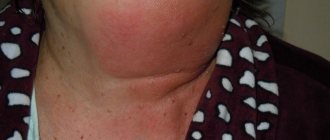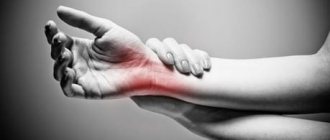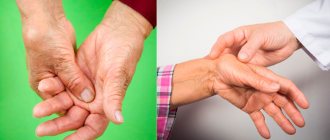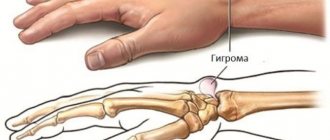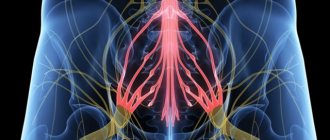Pain in the hand can be caused by various reasons. The whole arm or some part of it may hurt. The pain can be of a different nature: dull, burning or numbing, shooting or piercing, etc., it can occur suddenly or develop gradually.
Typically, people experiencing pain in their hand complain of:
- Pain in the wrist, palms and hands;
- Elbow pain;
- Shoulder pain;
- Pain in the shoulder blade.
Pain in the hand is often a consequence of various injuries, overexertion, and can occur as a result of excessive physical activity or prolonged work in an uncomfortable position. For example, a common occupational disease in our time among those who work at a computer for a long time has acquired the name “tunnel syndrome.” Pain in the arm can be one of the symptoms of diseases of the cardiovascular system, musculoskeletal system, nerve trunks and endings.
If there are no visible external injuries, it is necessary to check the condition of the cervical spine, since the cause of pain may be a protrusion or herniation of the intervertebral disc. Pain in the hand is not always felt directly at the site of injury; if the wrist is affected, it often spreads to the forearm area. Sometimes pain in the upper arm occurs as a result of heavy lifting. It can also be caused by an inflammatory process in the tendons of the shoulder muscles.
If pain has already appeared, discomfort does not go away for more than 3 days or periodically recurs for no apparent reason, you should go to an orthopedist.
Important information: Dear patients! If you have been diagnosed with rheumatoid arthritis, you need to see a rheumatologist. With a rheumatological profile, in addition to the joints, internal organs (heart, kidneys, etc.) may also suffer, so rheumatoid arthritis should be treated by a rheumatologist. The treatment of allergic, gouty and infectious arthritis is carried out by specialists of the relevant profile (allergists, rheumatologists and cardio-rheumatologists).
Orthopedic doctors successfully treat all other types of arthritis in children and adults (caused by sports and household injuries, excess body weight, age-related changes in joints).
Kinds
Discomfort in the hands may vary, since there are different types of pain:
- Burning. There is discomfort and burning, often a feeling of “goose bumps”.
- Aching. Periodically intensify and weaken, maybe 20-30 minutes.
- Spicy. With them, mobility decreases, muscle weakness and discomfort appear.
- Shots. They appear suddenly and last 2-3 minutes. This kind of pain is also called “cutting”.
Whatever the type of pain, it causes a lot of inconvenience. Therefore, it is important to consult a specialist in a timely manner in order not only to eliminate unpleasant symptoms, but also to prevent negative consequences.
Sprain: complete rest!
Another cause of discomfort in the arm area may be sprained ligaments or overstrain when the same movement is performed many times with the same arm. A sprain of the hand is expressed by sharp pain with a certain movement or position of the hand.
What to do. There is only one way out - stop the traumatic movement and keep your hand motionless for some time - at least a week. In some cases, doctors even recommend applying a fixative or plaster bandage. And take anti-inflammatory non-steroidal drugs, as well as painkillers.
Causes
Pain in the hands appears due to:
- bone fracture;
- ligament damage;
- injuries;
- strong physical activity;
- prolonged stay in an uncomfortable position;
- diseases of the musculoskeletal system;
- damage to nerve trunks;
- diseases of the heart, blood vessels;
- tendon inflammation;
- hand joint diseases.
With arthritis, pain appears in the early morning. Even during rest, the discomfort does not go away. There may also be swelling, hyperemia, and fever. With osteoarthritis, the cartilage of the joints becomes thin over time and leads to pain during physical activity, crunching, and difficulty moving.
If the cause is bursitis, then the pain manifests itself in the elbows, where swelling appears. The temperature also rises and the skin becomes red. Rheumatoid arthritis causes pain in small joints and morning stiffness.
Muscle spasm: hold the hand correctly
There is another, quite common cause of pain in the hands of people who work on a computer - this is the so-called tunnel syndrome, which doctors started talking about quite recently. The essence of the problem is that due to overstrain of the same muscle group, a spasm occurs, which impairs the nutrition of the nerves passing through the arm. Gradually, the channel through which the nerves pass imperceptibly narrows and the muscles and tendons begin to put more and more pressure on the nerves, aggravating the situation.
What to do. According to neurologist Larisa Buzukova, treating this disease is more difficult than preventing it. To ensure sufficient prevention, you need to take care of the correct position of your hands while working at the computer:
make sure that your elbow bends at a right angle; the brush should lie on the table as far from the edge as possible.
Use special wrist pads designed for computer work: a curved mouse pad, a specially shaped stand, or a computer desk.
It’s also good to periodically do exercises for your hands during your working day:
1. Shake your hands, relaxing them, as if shaking water from your fingers.
2. Clench your fists, unclench them, spreading your fingers wide.
3. Rotate your fists around your axis clockwise and counterclockwise.
4. Place your palms in front of you and press one hand onto the fingers of your other hand so that your wrist turns outward.
Which doctor treats you?
If you have unexplained pain in your arm, you should consult a neurologist. Who will do the treatment depends on the cause of the illness. You can immediately contact a traumatologist.
Pain in the arm, regardless of the nature of the pain syndrome (burning, sharp, aching or cutting), requires careful examination and close supervision of a specialist.
IMPORTANT! A person should not ignore this symptom or self-medicate, because the cause of pain in the arm can be associated with both muscle pathology and an inflammatory process that urgently needs to be stopped.
Make an appointment with a neurologist or traumatologist at the Kuntsevo Medical and Rehabilitation Center to determine the causes of the unpleasant symptom and eliminate it.
Sign up
Numb hands: the neck is to blame
Are you familiar with this condition when in the morning your hands, like someone else’s, go numb, lose sensitivity and have difficulty “returning to life”. What's the matter? Oddly enough, the reason should be sought not in the hands, but much higher - in the neck. This is how cervical osteochondrosis manifests itself. The nerves that control the movements of the arms pass through the cervical vertebrae, and if they are compressed, compressed or damaged due to osteochondrosis, then unpleasant sensations in the limbs will not be long in coming.
What to do. An employee of the Research Institute of Neurology of the Russian Academy of Medical Sciences, Candidate of Medical Sciences Lev Manvelov advises before going to bed to rub the back of the neck with a brush with natural bristles until you feel a pleasant warmth in this area, which indicates improved blood circulation. A warm shower aimed at the neck area and a small set of exercises that are good to repeat in the morning and evening will also help.
1. Slowly rotate your neck so that your head rolls over one shoulder, over your chest, over the other shoulder, over your back.
2. Stretch your ear to your right shoulder, then to your left.
3. Imagine that you have a ball on your chest and vigorously push it with your chin.
4. Bend your elbows, hands towards your shoulders, make several circular rotational movements back and forth.
Treatment methods
In our center you can undergo diagnostics - MRI, ultrasound. Research is performed after determining the location and nature of the pain. If necessary, additional blood tests are required to determine whether there are infectious and inflammatory diseases in the body.
The treatment method depends on the disease or injury that caused the pain. At the clinic, specialists prescribe the following treatment methods:
- Physiotherapy;
- Manual therapy;
- Reflexology;
- Physiotherapy;
It is up to the doctor to decide which procedures will be performed. Sometimes, when you have pain in your arms, you need to carry out several measures in combination. Experienced neurologists use effective therapy methods. Patients can perform diagnostics, undergo diagnostics and treatment without leaving the clinic.
Diagnostics
A patient who complains of heaviness in his hands is examined by different specialists: in addition to the therapist, an orthopedic traumatologist, a neurologist, and a vascular surgeon are involved in the diagnostic search. During a physical examination, attention is paid to skin color (pallor or cyanosis), the presence of edema, and deformation of bone structures. For diagnostic purposes, the most informative are:
- Radiography.
An X-ray of the hands in 2 projections helps to detect inflammatory or destructive processes in bone tissue, deformation of bones and joints. To clarify the diagnosis, a highly informative computed tomography scan of the hand is indicated. If you need to study the condition of soft tissues and nerves, an MRI of the hand is performed. - Vascular ultrasound.
Duplex scanning of the veins and arteries of the arms allows you to assess the speed of blood flow, identify blood clots or vasospasm, and visualize the collateral network. To examine in detail the vascular network of the upper extremities, ultrasound is complemented by radiocontrast angiography. - Electrophysiological diagnostics.
ENMG is prescribed if a neuromuscular origin of heaviness in the arms is suspected. During the study, the doctor determines the speed of the nerves’ response to stimuli, determines the localization and extent of the problem, and differentiates nervous and vascular pathology. - Lab tests.
To assess general changes indicating inflammation or systemic connective tissue diseases, a hemogram and biochemical blood test are performed. In case of thrombosis, the results of a coagulogram are required. To confirm dermatomyositis, specialists perform a histological examination of muscle biopsies. - Additional methods.
To diagnose diseases of the lymphatic system, X-ray lymphography and lymphoscingyrgaphy are performed. Studies show areas of tortuosity, lymphangiectasia, and valve insufficiency. In case of possible professional neurosis, consultation with a psychiatrist is recommended.
Upper limb massage
Rehabilitation and lifestyle restoration
After treatment, patients need to recover. This is achieved using:
- maintaining moderate physical activity;
- balanced nutrition;
- compliance with the work and rest regime;
- taking vitamin and mineral complexes;
- maintaining correct posture;
- protection against hypothermia of joints and stress;
- correction of deformed joints;
- disinfection of wounds, scratches and abrasions;
- refusal of monotonous and monotonous work;
- timely treatment of infectious diseases;
- limiting alcohol consumption.
Lifestyle with pain in the hands
A healthy lifestyle is necessary, which consists of the absence of bad habits. To do this, it is important to give up alcohol and cigarettes. It is necessary to monitor your diet. The menu should not include fried, salty, spicy foods. You should drink more clean water and avoid coffee.
Moderate exercise is necessary. Moreover, you can choose running, exercise or swimming. Yoga is also suitable. Only with the right lifestyle can you maintain your health at a normal level. By contacting us, patients will be able to successfully undergo treatment and rehabilitation in one place.
Dermatitis: Watch your gut
Quite often, red, dry, itchy areas appear on the hands of women suffering from allergies; blisters and small pustules may appear. This is the so-called contact dermatitis, which is also called housewives dermatitis. If urgent measures are not taken, then over time crusts may form in these places, the skin will become covered with painful cracks, sometimes even ulcers, which will heal over time.
Most often, at the beginning of the disease, a woman does not fully understand the danger and continues to do laundry, wash dishes with detergents, scrub tiles using cleaning powders and lubricate her hands with creams. All this only aggravates the painful process, since it is the contact of the skin with various chemicals that causes dermatitis. Eventually, irritated skin reacts to ordinary toilet soap and chlorinated water.
What to do. First of all, you need to understand that any skin disease has very deep roots. It may indicate improper functioning of the stomach or intestines, gallbladder, and problems with the kidneys and immune system. Therefore, before working with your hands, you need to be examined by specialists.
In addition, you need to at least temporarily eliminate from your daily routine everything that irritates the skin of your hands. Use housekeeping gloves. If possible, it is best to give up washing dishes for a while, agreeing with your family that they will take on this responsibility. As a last resort, you can wash the dishes with a long-handled brush.
Wash your hands infrequently and not with ordinary toilet soap, but with liquid soap and cream, it irritates the skin less. After each hand washing, dry them thoroughly with a dry, clean towel and lubricate them with hypoallergenic hand cream. If ulcers still appear on your hands, you need to consult an allergist or dermatologist.
To activate the excretory systems that help cleanse our body, you need to regularly drink sorbents: these are activated carbon, polyphepane, and enterosgel. Some products have similar properties - for example, baked apples, cranberries, green tea.

